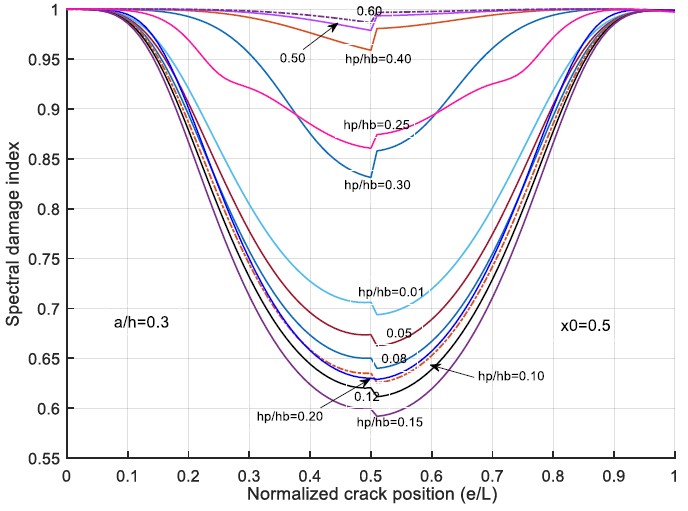Frequency response function of cracked Timoshenko beam measured by a distributed piezoelectric sensor
Author affiliations
DOI:
https://doi.org/10.15625/0866-7136/20575Keywords:
frequency response function, cracked Timoshenko beam, piezoelectric layer, sensitivity analisisAbstract
In the present report, a novel concept of frequency response function (FRF) is introduced for piezoelectric beam. First, a model of Timoshenko beam bonded with a piezoelectric layer is established and used for deriving the conventional frequency response function acknowledged as mechanical frequency response function (MERF). Then, the output charge produced in the piezoelectric layer is calculated from the MFRF and therefore obtained frequency-dependent function is called electrical frequency response function (EFRF) for the integrated beam. This concept of FRF depends only on exciting position and can be explicitly expressed through crack parameters. So that it provides a novel instrument to modal analysis and structural health monitoring of electro-mechanical systems, especially for crack detection in beams using distributed piezoelectric sensor. The sensitivity of EFRF to crack has been examined and illustrated in numerical examples for cracked Timoshenko beam.
Downloads
References
H. Sohn, C. R. Farrar, F. M. Hemez, D. D. Shunk, D. W. Stinemates, B. R. Nadler, and J. J. Czarnecki. A review of structural health monitoring literature: 1996–2001. Los Alamos National Laboratory Report, (2003).
W. Fan and P. Qiao. Vibration-based damage identification methods: A review and comparative study. Structural Health Monitoring, 10, (2010), pp. 83–111.
R. Hou and Y. Xia. Review on the new development of vibration-based damage identification for civil engineering structures: 2010–2019. Journal of Sound and Vibration, 491, (2021).
Z. Wang, R. M. Lin, and M. K. Lim. Structural damage detection using measured FRF data. Computer Methods in Applied Mechanics and Engineering, 147, (1997), pp. 187–197.
S. K. Thyagarajan, M. J. Schulz, P. F. Pai, and J. Chung. Detecting structural damage using frequency response functions. Journal of Sound and Vibration, 210, (1998), pp. 162–170.
R. P. C. Sampaio, N. M. M. Maia, and J. M. M. Silva. Damage detection using the frequency-response-function curvature method. Journal of Sound and Vibration, 226, (1999), pp. 1029–1042.
U. Lee and J. Shin. A frequency response function-based structural damage identification method. Computers & Structures, 80, (2002), pp. 117–132.
N.-G. Park and Y.-S. Park. Damage detection using spatially incomplete frequency response functions. Mechanical Systems and Signal Processing, 17, (2003), pp. 519–532.
H. Y. Hwang and C. Kim. Damage detection in structures using a few frequency response measurements. Journal of Sound and Vibration, 270, (2004), pp. 1–14.
X. Liu, N. A. J. Lieven, and P. J. Escamilla-Ambrosio. Frequency response function shape-based methods for structural damage localisation. Mechanical Systems and Signal Processing, 23, (2009), pp. 1243–1259.
M. Dilena, M. P. Limongelli, and A. Morassi. Damage localization in bridges via the FRF interpolation method. Mechanical Systems and Signal Processing, 52–53, (2015), pp. 162–180.
E. F. Crawley and J. de Luis. Use of piezoelectric actuators as elements of intelligent structures. AIAA Journal, 25, (1987), pp. 1373–1385.
H. S. Tzou and C. I. Tseng. Distributed piezoelectric sensor/actuator design for dynamic measurement/control of distributed parameter systems: A piezoelectric finite element approach. Journal of Sound and Vibration, 138, (1990), pp. 17–34.
D.Wang, H. Song, and H. Zhu. Electromechanical impedance analysis on piezoelectric smart beam with a crack based on spectral element method. Mathematical Problems in Engineering, 2015, (2015), pp. 1–13.
W. Na and J. Baek. A review of the piezoelectric electromechanical impedance based structural health monitoring technique for engineering structures. Sensors, 18, (2018).
T. Wang, B. Tan, M. Lu, Z. Zhang, and G. Lu. Piezoelectric electro-mechanical impedance (EMI) based structural crack monitoring. Applied Sciences, 10, (2020).
S. Bhalla and C.-K. Soh. Progress in structural health monitoring and non-destructive evaluation using piezo-impedance transducers. Smart Materials and Structures: New Research, Nova Science Publishers, Inc., New York, (2007), pp. 177–228.
N. T. Khiem, T. T. Hai, L. K. Toan, N. T. Lan, and H. Q. Quyet. A novel criterion for crack detection in beam structures by frequency response functions. Vietnam Journal of Mechanics, 45, (2023), pp. 273–286.
T. G. Chondros, A. D. Dimarogonas, and J. Yao. Longitudinal vibration of a continuous cracked bar. Engineering Fracture Mechanics, 61, (1998), pp. 593–606.
T. G. Chondros, A. D. Dimarogonas, and J. Yao. A continuous cracked beam vibration theory. Journal of Sound and Vibration, 215, (1998), pp. 17–34.
T. T. Hai, P. T. Hang, and N. T. Khiem. A novel criterion for crack identification in beamlike structures using distributed piezoelectric sensor and controlled moving load. Journal of Sound and Vibration, 572, (2024).
R. J. Allemang. The modal assurance criterion–twenty years of use and abuse. Sound and Vibration, 37, (8), (2003), pp. 14–23.
E. J. Williams and A. Messina. Applications of the multiple damage location assurance criterion. Key Engineering Materials, 167–168, (1999), pp. 256–264.
N. T. Khiem, T. T. Hai, and L. Q. Huong. Effect of piezoelectric patch on natural frequencies of Timoshenko beam made of functionally graded material. Materials Research Express, 7, (2020).

Downloads
Published
How to Cite
License

This work is licensed under a Creative Commons Attribution-ShareAlike 4.0 International License.









